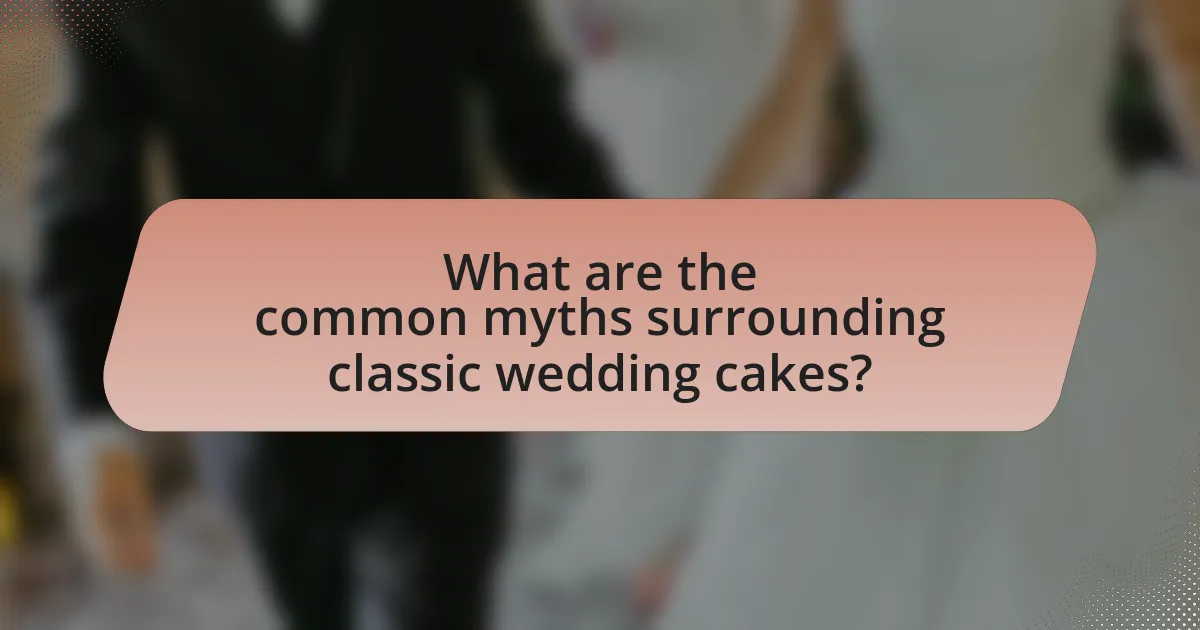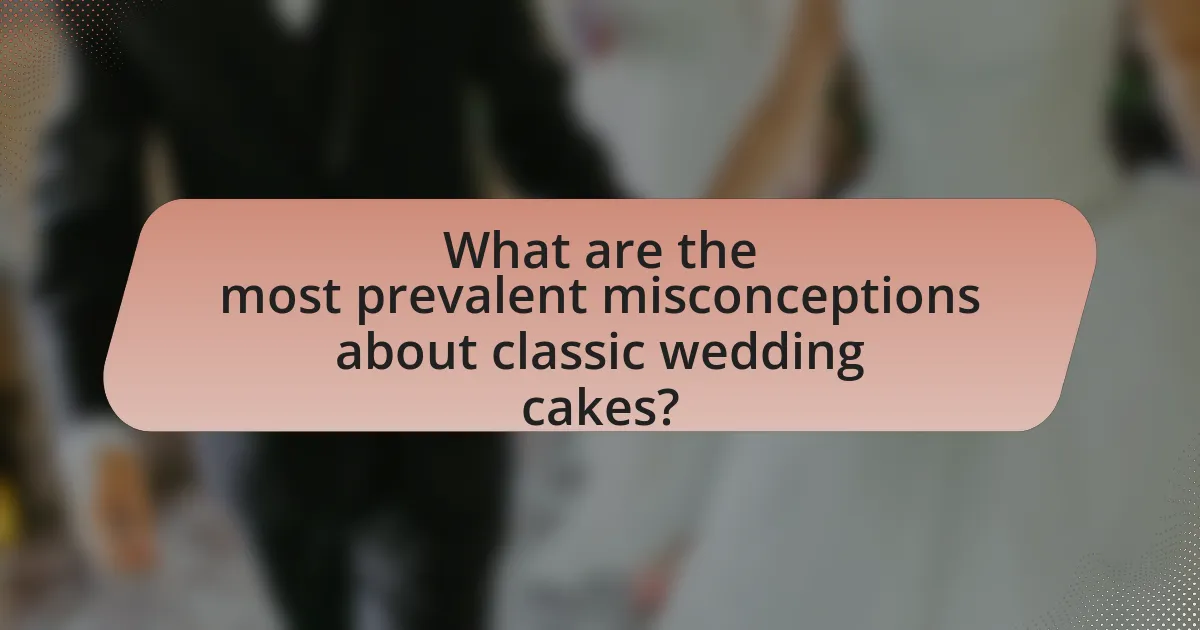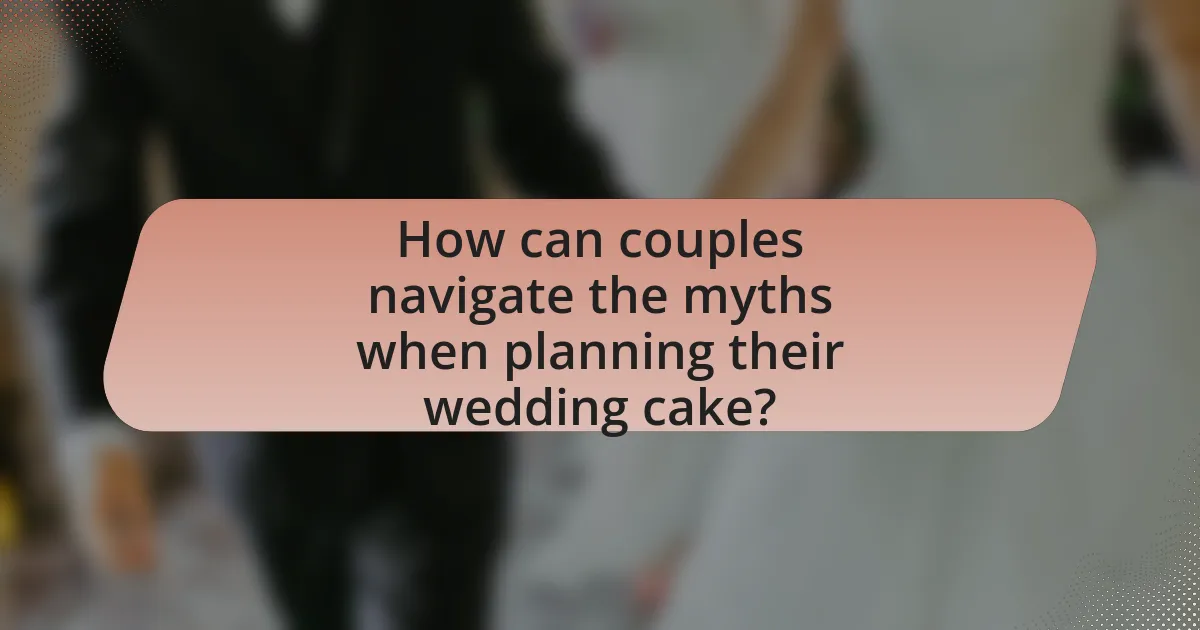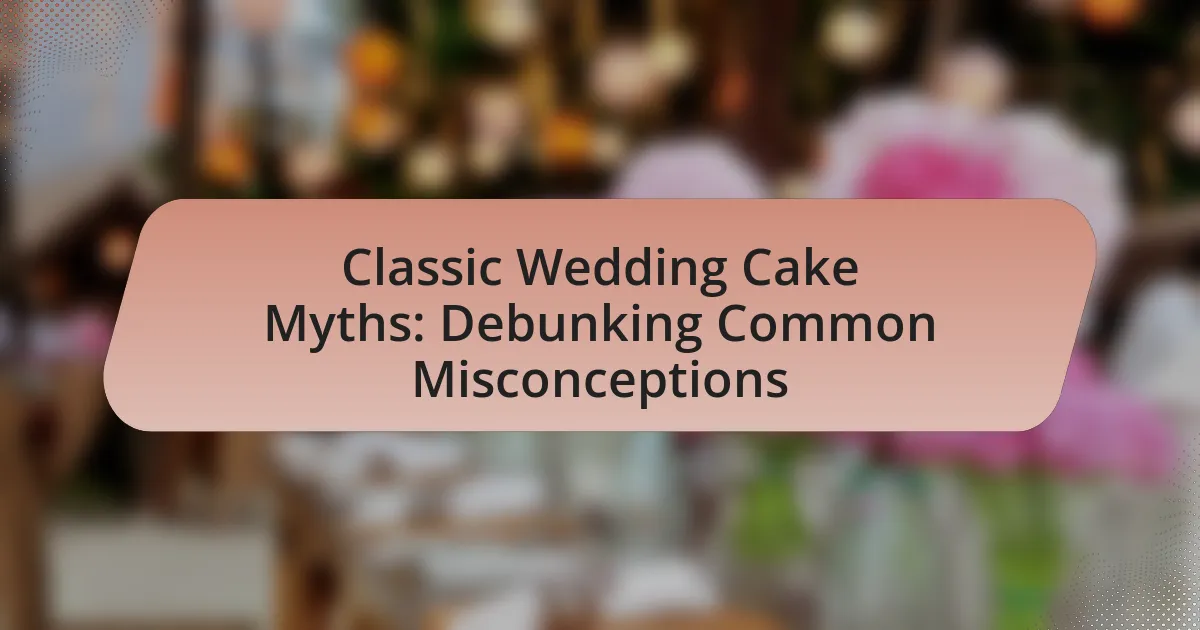Classic wedding cake myths often include the misconceptions that wedding cakes must be fruitcake, are exclusively for traditional weddings, and are always expensive. These beliefs have historical roots, stemming from ancient rituals and cultural practices that have evolved over time. The article explores the origins of these myths, the psychological factors that contribute to their persistence, and how social media and popular culture reinforce these misconceptions. It also highlights modern trends in wedding cakes, emphasizing the variety of flavors and designs available today, and offers guidance for couples on how to navigate these myths when planning their wedding cake.

What are the common myths surrounding classic wedding cakes?
Common myths surrounding classic wedding cakes include the belief that they must be fruitcake, that they are only for traditional weddings, and that they must be expensive. Many people assume that a wedding cake must be a dense fruitcake, but modern trends favor lighter options like sponge or buttercream cakes. Additionally, while classic wedding cakes often feature white icing and tiered designs, couples today frequently choose unique styles that reflect their personalities, breaking the notion that they must adhere to tradition. Lastly, the idea that wedding cakes are prohibitively expensive is misleading; many bakeries offer a range of options to fit various budgets, making it possible to have a beautiful cake without overspending.
How did these myths originate?
Classic wedding cake myths originated from cultural traditions and historical practices surrounding weddings. These myths often stem from ancient rituals, such as the Roman custom of breaking bread over the bride’s head to symbolize fertility and prosperity. Over time, these practices evolved into modern interpretations, leading to misconceptions about the significance and symbolism of wedding cakes. For example, the belief that a wedding cake must be multi-tiered for good luck is rooted in the historical association of abundance and prosperity with larger cakes.
What historical events contributed to the creation of these myths?
The historical events that contributed to the creation of classic wedding cake myths include the Victorian era’s emphasis on elaborate celebrations and the introduction of sugar as a luxury item. During the 19th century, weddings became grand social events, leading to the tradition of multi-tiered cakes symbolizing prosperity and good fortune. Additionally, the use of white icing, popularized by Queen Victoria’s wedding cake in 1840, established the association of white cakes with purity and celebration. These events shaped societal expectations and beliefs surrounding wedding cakes, embedding them in cultural narratives.
Which cultural influences shaped the perception of wedding cakes?
Cultural influences that shaped the perception of wedding cakes include ancient Roman traditions, medieval European customs, and modern American practices. In ancient Rome, cakes made of wheat or barley were used in wedding ceremonies to symbolize fertility and prosperity. During the medieval period in Europe, the custom of stacking cakes became popular, with the tiered cake representing the couple’s future prosperity and unity. In contemporary America, the wedding cake has evolved into a symbol of celebration and status, often elaborately decorated to reflect personal tastes and cultural backgrounds. These historical practices and evolving traditions have collectively influenced how wedding cakes are perceived today, emphasizing their significance in marital celebrations.
Why do people believe in these classic wedding cake myths?
People believe in classic wedding cake myths due to cultural traditions and societal influences that perpetuate these narratives. These myths often stem from historical practices, such as the belief that a multi-tiered cake symbolizes prosperity and good fortune, which has been passed down through generations. Additionally, the emotional significance of weddings amplifies the acceptance of these myths, as couples seek to adhere to customs that are thought to enhance their marital happiness. The prevalence of these beliefs is further reinforced by media portrayals and social gatherings where such myths are shared and celebrated, creating a cycle of acceptance and continuation.
What psychological factors contribute to the persistence of these myths?
Cognitive biases significantly contribute to the persistence of wedding cake myths. Confirmation bias leads individuals to favor information that supports their pre-existing beliefs about wedding cakes, while ignoring contradictory evidence. Additionally, the availability heuristic causes people to rely on easily recalled examples, often perpetuating myths that are widely circulated in popular culture. Social proof also plays a role, as individuals may adopt beliefs about wedding cakes based on what others in their social circles accept as true, reinforcing these misconceptions. Research indicates that these psychological factors create a feedback loop, where myths are continuously validated and propagated within communities, making them resistant to change.
How do social media and popular culture reinforce these misconceptions?
Social media and popular culture reinforce misconceptions about wedding cakes by perpetuating idealized images and narratives that often do not reflect reality. Platforms like Instagram and Pinterest showcase extravagant wedding cakes that emphasize perfection and luxury, leading individuals to believe that such standards are the norm. This visual representation creates unrealistic expectations, as studies indicate that 70% of brides feel pressured to meet these societal standards, which can distort their perceptions of what a wedding cake should be. Additionally, popular culture, through movies and television, often depicts wedding cakes as central symbols of romance and success, further embedding these misconceptions into societal norms.

What are the most prevalent misconceptions about classic wedding cakes?
The most prevalent misconceptions about classic wedding cakes include the belief that they must be fruitcake, that they are always overly expensive, and that they must be multi-tiered. Many people assume that traditional wedding cakes are exclusively fruitcakes, but in reality, a variety of flavors, such as vanilla, chocolate, and red velvet, are commonly used. Additionally, while some wedding cakes can be costly, the price varies widely based on design, ingredients, and location, allowing for budget-friendly options. Lastly, the notion that wedding cakes must be multi-tiered is misleading; many couples opt for single-tier cakes or alternative desserts that suit their preferences and wedding themes. These misconceptions often stem from outdated traditions and societal expectations rather than current trends and individual choices.
Is it true that wedding cakes must be fruitcake?
Wedding cakes do not have to be fruitcake. While fruitcake has historically been a popular choice for wedding cakes, especially in certain cultures, modern weddings feature a variety of cake types, including sponge, chocolate, and buttercream cakes. The choice of cake ultimately depends on personal preference, and there are no strict rules mandating that wedding cakes must be fruitcake.
What are the origins of the fruitcake tradition in weddings?
The fruitcake tradition in weddings originates from ancient Roman times, where a mixture of grains, honey, and fruits was used to celebrate fertility and prosperity. This practice evolved through the Middle Ages, particularly in England, where fruitcakes became popular for their ability to be preserved for long periods, making them suitable for special occasions like weddings. Historical records indicate that fruitcakes were often made with rich ingredients such as dried fruits, nuts, and spices, symbolizing wealth and good fortune for the couple. The tradition solidified in the 19th century when fruitcakes became a standard wedding cake choice, reflecting societal values of abundance and celebration.
What alternative cake flavors are popular for weddings today?
Alternative cake flavors popular for weddings today include red velvet, lemon, chocolate ganache, and carrot cake. These flavors have gained traction as couples seek unique options beyond traditional vanilla and chocolate. For instance, red velvet offers a visually striking appearance and a subtle cocoa flavor, while lemon provides a refreshing citrus twist. Chocolate ganache is favored for its rich, indulgent taste, and carrot cake appeals for its moist texture and spiced flavor profile. The shift towards these alternative flavors reflects changing preferences in wedding cake choices, emphasizing personalization and creativity in modern celebrations.
Do wedding cakes have to be multi-tiered?
Wedding cakes do not have to be multi-tiered. While multi-tiered cakes are traditional and often seen at weddings, couples can choose single-tier cakes or any other design that suits their preferences. The choice of cake style is ultimately based on personal taste, budget, and the number of guests, making multi-tiering unnecessary for every wedding.
What are the benefits of choosing a single-tier cake?
Choosing a single-tier cake offers several benefits, including simplicity, cost-effectiveness, and ease of serving. A single-tier cake is generally less expensive than multi-tier options, as it requires fewer ingredients and less intricate decoration. Additionally, it simplifies the serving process, making it easier for guests to enjoy without the need for cutting multiple layers. This type of cake is also ideal for smaller gatherings, ensuring that there is enough cake for everyone without excess waste.
How can couples creatively display a smaller cake?
Couples can creatively display a smaller cake by using tiered stands or decorative cake pedestals to elevate the cake, making it visually striking. This method draws attention to the cake’s design and can enhance the overall aesthetic of the wedding decor. Additionally, incorporating fresh flowers or greenery around the base of the cake can create a beautiful, natural presentation that complements the wedding theme. Using unique serving dishes or incorporating themed elements, such as personalized cake toppers, can further personalize the display and make it memorable.

How can couples navigate the myths when planning their wedding cake?
Couples can navigate the myths when planning their wedding cake by educating themselves on common misconceptions and seeking advice from reputable sources. For instance, many believe that a wedding cake must be a traditional fruitcake, but modern trends show that couples can choose flavors that reflect their personal tastes, such as chocolate or red velvet. Additionally, some think that a larger cake is always necessary, but the average wedding cake serves about 100 guests, and couples can opt for smaller cakes or alternative desserts to suit their guest list. By consulting with experienced bakers and researching current wedding cake trends, couples can make informed decisions that align with their preferences while debunking outdated myths.
What should couples consider when choosing their wedding cake?
Couples should consider flavor, design, size, dietary restrictions, and budget when choosing their wedding cake. Flavor is crucial as it impacts guest satisfaction; popular choices include vanilla, chocolate, and red velvet. The design should reflect the wedding theme and personal style, with options ranging from classic to modern aesthetics. Size is important to ensure there is enough cake for all guests, typically calculated based on the number of attendees. Dietary restrictions, such as gluten-free or vegan options, should be addressed to accommodate all guests. Lastly, the budget will dictate the complexity of the cake, as custom designs and premium ingredients can significantly increase costs.
How can they incorporate personal preferences into their cake choice?
Individuals can incorporate personal preferences into their cake choice by selecting flavors, designs, and ingredients that reflect their tastes and values. For example, couples can choose flavors that they enjoy, such as chocolate or vanilla, and incorporate personal touches like favorite colors or themes into the cake’s design. Additionally, they can opt for specific dietary considerations, such as gluten-free or vegan options, to align with their lifestyle choices. This approach ensures that the cake not only serves as a centerpiece but also resonates with the couple’s unique identity and preferences.
What role does budget play in selecting a wedding cake?
Budget plays a crucial role in selecting a wedding cake as it directly influences the size, design, and quality of ingredients used. A limited budget may restrict options to simpler designs and smaller sizes, while a higher budget allows for elaborate decorations and premium ingredients. According to a survey by The Knot, couples in 2021 spent an average of $350 on their wedding cake, indicating that budget considerations significantly shape choices in cake selection.
What are some tips for debunking wedding cake myths?
To debunk wedding cake myths effectively, focus on providing factual information and addressing common misconceptions directly. First, clarify that many myths stem from outdated traditions or personal anecdotes rather than evidence. For instance, the belief that fruitcake is the only traditional wedding cake is incorrect; many cultures have diverse cake options. Second, use credible sources to support your claims, such as culinary experts or historical references, to validate that modern cakes can be just as traditional as fruitcake. Lastly, encourage couples to prioritize their preferences over myths, emphasizing that the best wedding cake is one that reflects their taste and style, not outdated beliefs.
How can couples educate their guests about their cake choices?
Couples can educate their guests about their cake choices by providing detailed descriptions of the flavors, ingredients, and any unique aspects of the cake during the wedding reception. This can be achieved through printed menus at each table, signage near the cake display, or even a brief announcement by the couple or the officiant. For instance, if the cake features a specific cultural significance or a unique flavor combination, sharing this information helps guests appreciate the choices made. Additionally, couples can include this information in their wedding website or invitations, allowing guests to understand the thought process behind the cake selection before the event.
What resources are available for couples to learn more about wedding cake options?
Couples can learn more about wedding cake options through various resources, including wedding planning websites, cake design blogs, and social media platforms. Websites like The Knot and WeddingWire provide extensive guides and reviews on different cake styles, flavors, and bakeries. Cake design blogs often feature expert advice and showcase trending designs, helping couples visualize their options. Additionally, social media platforms like Instagram and Pinterest are valuable for discovering creative ideas and connecting with local bakers. These resources collectively offer a comprehensive understanding of wedding cake choices, ensuring couples make informed decisions.
